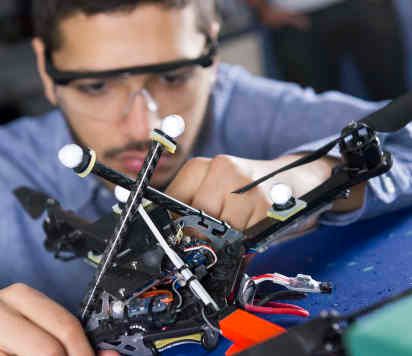
Danielle O’Driscoll's PhD focuses on the Design of Rigid-Deployable Aeroshells for Atmospheric Entry.
Background
"I obtained my Master’s in Aeronautical Engineering at Imperial College London in 2017. Then I started my PhD after completing a year on the Young Graduate Trainee programme at the European Space Agency."
"For the programme, I moved to the Netherlands and worked at European Space Research and Technology Centre (ESTEC) in the structures division, with a focus on characterising the launch environment. This meant carrying out vibration analysis on spacecraft and then comparing the results to test data for qualification. I also conducted my own experiment on one of the shaker tables with another trainee."
"During my final year of undergraduate study, I completed my Master’s project under Dr. Matthew Santer (who is now my PhD supervisor along with Dr. Paul Bruce) on the design of deployable origami-based solar arrays. I discovered that I really enjoyed independent research and developed a keen interest in deployable space structures."
Research and applications
"My research is centred around the design of a new type of aeroshell – the structure that thermally protects and decelerates a spacecraft as it enters the first 100 km of a planet’s atmosphere. Up until now, aeroshells have been constructed with a rigid-fixed geometry and their size has been constrained by the diameters of current launch vehicles’ payload modules. If we want to send high-mass missions, such as large robotic systems or even humans, to other planets, much larger aeroshells will be needed to slow down the spacecraft sufficiently."
Mars Entry
"Therefore, my work has focused on the development of a rigid-deployable aeroshell geometry that allows compact stowage inside the payload module of a rocket, and that deploys to a large surface area before reaching a planet’s atmosphere. My research has consisted mainly of computational work: generating an optimised folding geometry and analysing the aeroshell’s deployment characteristics. During the final year of my PhD, I will be constructing a 2.6 m diameter engineering model to validate these simulated results."
Aspirations and Challenges
"I hope to continue in academic or industrial research, with a focus on deployable space structures. It would be exciting to move to another country as well. I would also love to go to space, but that depends on a lot of factors!"
"I have most enjoyed the creative side of my project, which has been determining the exact origami ‘folds’ required to achieve the seamless aeroshell geometry required in the deployed configuration. There are many small geometric variables that affect the precision of this final positioning so it has been very satisfying to see all the parts come together smoothly."
"The most challenging aspect of the project has definitely been the development of the aeroshell engineering model. Thankfully, Dr. Michela Gramola, a current postdoc, and Tianshu Wang, another PhD student, have joined the project. So we’ve been able to spread out the tasks of material selection, design of manufacturable parts and deployment analysis. It will be really exciting to see and test the aeroshell when it has been constructed!"
Advice and living in London
"There isn’t anything I would change about how I applied, but I would tell anyone else applying to make sure you find the topic you are going to research engaging!"
"I have loved living and studying in London; especially having the opportunity to try new activities and meet new people."



